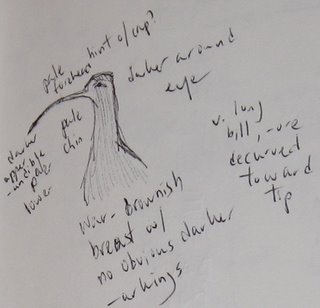On this day in 1997, a juvenile Curlew Sandpiper was identified by Bob Confer in a farm field near the Clarksville Sod Farm in Burlington County. Although the bird was present for a few days before this (Dasey 1997), looks sufficient for identification only came on the 7th. Ed Bruder was the original finder of this bird. The bird remained for one more day, 8 September, then departed.
This individual went on to become the first fully accepted record of the species for NJ. Although the state has many previous reports, the NJBRC elected to review only post-1996 reports of this species due to the difficulty of unearthing adequate documentation on so many reports after the fact (Halliwell et al. 2000). John James Audubon himself reported shooting two Curlew Sandpipers in spring 1829 at Great Egg Harbor in Atlantic County (Stone 1965); this is the first known report for North America.
The Curlew Sandpiper might be thought of as a "regular rarity" in NJ; most years have at least one report of the species. Most reports come from May with a secondary peak in July (Hanson 1999). In contrast to many vagrant species, most reports are of adults rather than immatures, a pattern that holds across the Northeast. It remains uncertain whether juvenile Curlew Sandpipers are overlooked because their plumage is far subtler than that of an adult in even partial alternate plumage, or whether there is a real difference in distribution of these age classes. A fuller discussion of Curlew Sandpiper distribution can be found in Hanson (1999). In any case, the Burlington County bird is noteworthy for its age, since there are no other known reports of juvenile Curlew Sandpipers for the state.
The Burlington County location is also noteworthy. Curlew Sandpipers are known for their site loyalty; Brigantine NWR in Atlantic County is probably the classic example of a location traditionally favored by the species. Part of this site loyalty may stem from adult birds repeating a migration path throughout their lifetimes, but there is no hard information on this. Most of the favored locations have been coastal ones. On the other hand, the appearance of such species as
Pacific Golden-Plover and Sharp-tailed Sandpiper on inland sod farms demonstrates that rare shorebirds can show up in non-coastal locations.
Dasey, Ward W. 1997. 1996 Fall field notes, Region 4.
Records of New Jersey Birds 22:14-16.
Halliwell, Tom, Rich Kane, Laurie Larson, & Paul Lehman. 2000.
The Historical Report of the New Jersey Bird Records Committee: Rare Bird Reports Through 1989.
Records of New Jersey Birds 26:13-44.
Hanson, Jennifer W. 1999. Curlew Sandpipers (
Calidris ferruginea) in New Jersey.
Records of New Jersey Birds 25:26-31.
Stone, Witmer.
Bird Studies at Old Cape May: An Ornithology of Coastal New Jersey. Dover, New York, NY.


